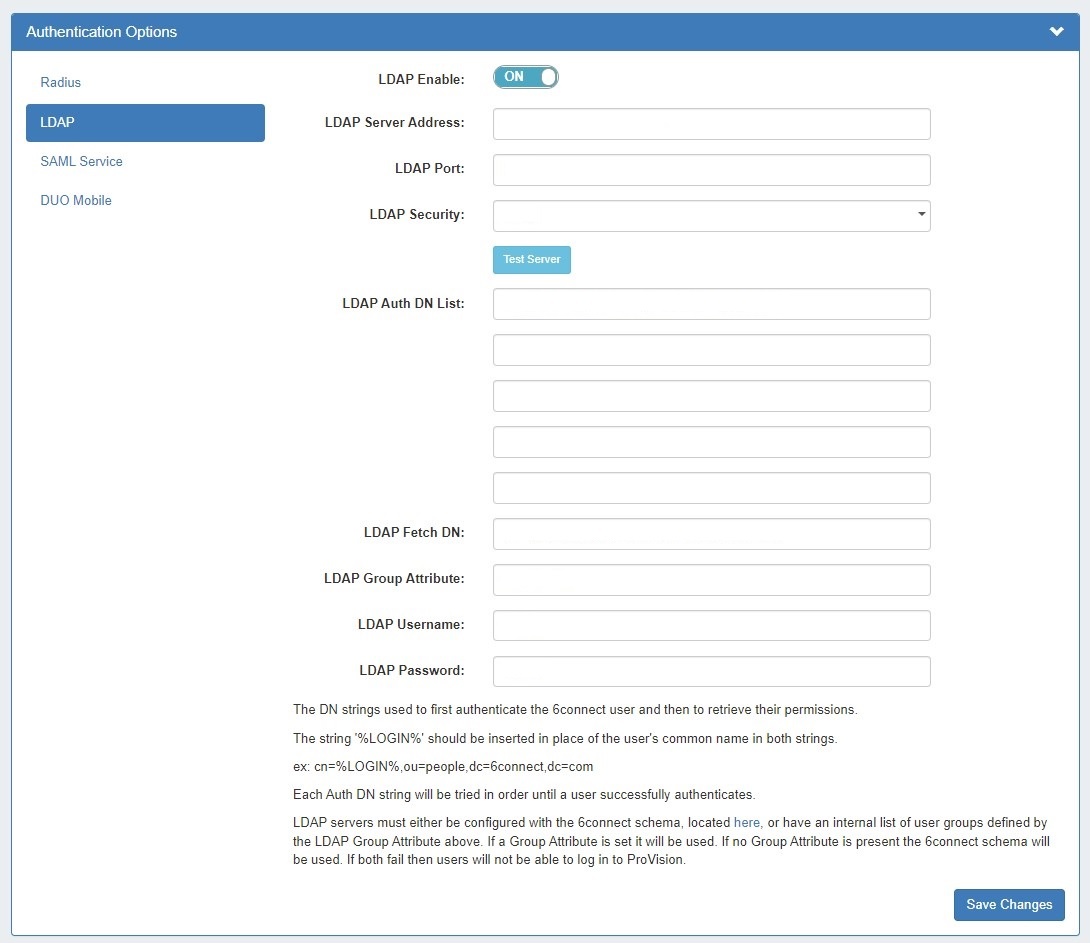| HTML |
|---|
<div id="google_translate_element"></div>
<script type="text/javascript">
function googleTranslateElementInit() {
new google.translate.TranslateElement({pageLanguage: 'en'}, 'google_translate_element');
}
</script>
<script type="text/javascript" src="//translate.google.com/translate_a/element.js?cb=googleTranslateElementInit"></script> |
LDAP Authentication
LDAP authentication options are accessed by clicking the "Authentication" sub-tab at the top of the Admin Settings page, then selecting "LDAP" from the "Authentication Options" module.
...
- Log into 6connect ProVision
- Go to Settings Tab → Admin Settings -> Authentication
- Select "LDAP" under "Authentication Options"
- Move the LDAP Enable selector to the "ON" position.
- Fill in the hostname or ip address, authentication port, LDAP Security, Auth DN List, and Fetch DN, and LDAP Group Attribute.
Example values in this case would be:
- LDAP Enable: (Checked)
- LDAP Server Address: IP or Domain, such as 1.2.3.4 or somelabserver.lab.com
- LDAP Port: 389 ( or SSL/TLS port is 636)
- LDAP Security: None
- LDAP Auth DN: cn=%LOGIN%,dc=6connect,dc=com
- LDAP Fetch DN: cn=%LOGIN%
- LDAP Group Attribute: memberOf
- LDAP Username / LDAP Password: Optionally, you may enter LDAP admin credentials to allow ProVision to import and sync LDAP contacts. See Contact Manager for details on LDAP contacts.
- Click "Test Server" to verify the connection.
- NOTE: If you experience authentication errors at this step, confirm the LDAP settings using an LDAP Search, as described in the previous section.
...
- LDAP Enable: Check the box to enable LDAP functionality.
- LDAP Server Address: The IP address or domain of your LDAP server.
- LDAP Port: 389 ( or SSL/TLS port is 636)
- LDAP Security: Select the security method of your LDAP server - SSL, TLS or None
- Test Server: Click to test the connection to the LDAP server.
- LDAP Auth DN List: A query string that will be used to authenticate the user against the LDAP server. %LOGIN% is a variable string that will be replaced with the user name. This may be in list format, and the auth system will try each to authenticate the user. (ex: cn=%LOGIN%,ou=people,dc=6connect,dc=com)
- LDAP Fetch DN: The LDAP query that will be used to pull the user object
- LDAP Group Attribute:The LDAP attribute that will hold the LDAP-GNI group links. If using an internal list of user groups instead of 6connect groups, enter the attribute name for the LDAP groups here. If a Group Attribute is set, it will be used first, otherwise the 6connect schema will be used.
- LDAP Username / LDAP Password: Optionally, you may enter LDAP admin credentials to allow ProVision to import and sync LDAP contacts. See Contact Manager for details on LDAP contacts.
- NOTE: Mapping Permissions to 6connect schema: To integrate 6connect permissions with your existing directory structure then you will need the 6connect schema. It should snap in with any existing LDAP structure and allow you to assign 6connect permissions to your existing users. You can download a copy of the schema.
When done, you may optionally click "Test Server" to verify the connection to the LDAP server with the entered settings, then "Save Changes".
...
